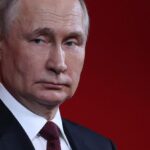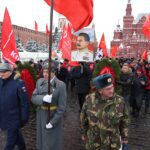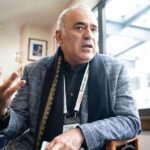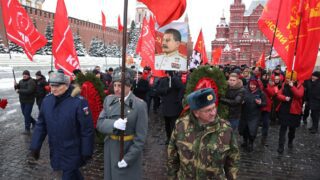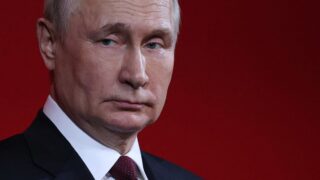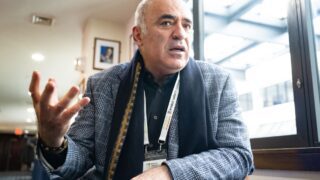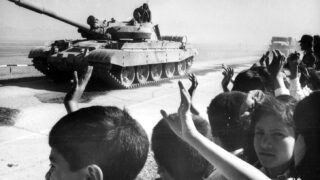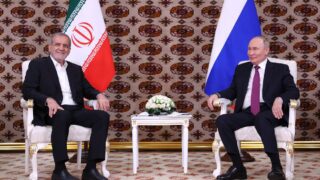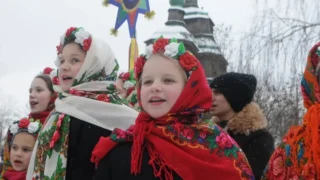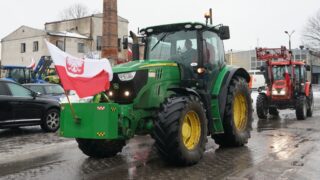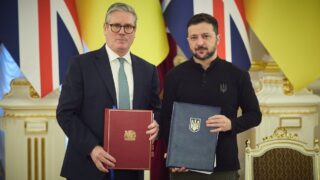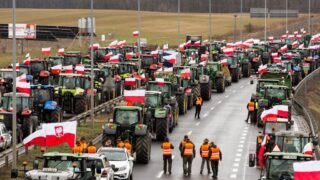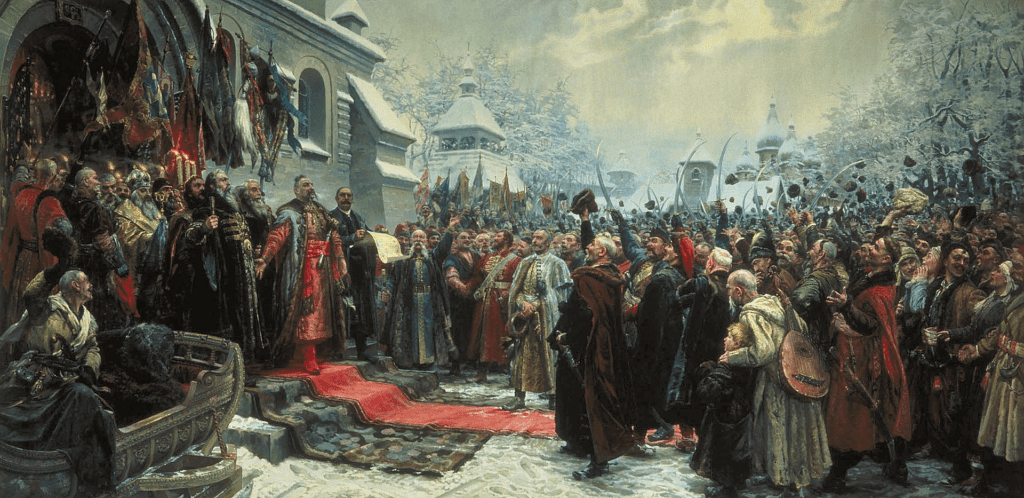
Ukraine’s fateful deal that unleashed centuries of Russian colonialism
On 18 January 1654, in the town of Pereiaslav, modern-day Ukraine, the leaders of the newly-formed Ukrainian Hetmanate swore allegiance to Muscovite Tsar Alexei I, hoping for military support in their fight for independence against Poland.
Just 13 years later, Muscovy would betray that promise, carving up Ukrainian lands with Poland, the very power it had vowed to protect Ukraine from. A century later, the emerging Russian Empire fully absorbed Ukrainian territories, erasing the last remnants of Ukrainian statehood and plunging the region into centuries of colonial rule.
Over the centuries, the 1654 Pereiaslav Agreement has become one of the most hotly debated milestones in Russian-Ukrainian history, and a key pillar in Russia’s colonial claims, fueling Kremlin’s expanion from the 17th century through to the Putin’s ongoing invasion of Ukraine.
Russian security pledge that buried Ukrainian statehood
The history of the treaty known as the Pereiaslav Agreements dates back to 1648, when the Cossacks – a self-governing military class that emerged in present-day Ukraine in the mid-16th century – rose up against the Polish-Lithuanian Commonwealth, the Polish-dominated monarchy that had ruled Ukrainian lands for over a century.
The 1648 rebellion, led by the noble Bohdan Khmelnytskyi, surged through Ukraine, decisively defeating the Polish army and paving the way for the birth of the independent Cossack state, the Hetmanate, just months after the uprising began.
However, with its newfound independence under constant threat from Polish royal forces eager to reclaim lost territories, the fledgling state quickly found itself in desperate need of foreign allies to secure its survival.
From the outset of the war, Khmelnytskyi pursued alliances with neighbouring powers — from the Ottoman Empire and Crimean Tatars in the south to Wallachia and Transylvania in the west, and Muscovy in the east.
By late 1653, after the failure of the Ottoman and Crimean Tatar alliances, Ukraine turned once again to Muscovy, a negotiation that had started in 1648. The shared Orthodox faith and common history in the medieval Rus state, which once united both territories, made this alliance seem more viable than previous ones.
The negotiations reached a turning point on 18 January 1654, when a Muscovite delegation arrived in Pereiaslav for a council. It was here that the cultural and political divide between the two sides became clear.
Khmelnytskyi demanded that the Muscovite envoys swear an oath on behalf of Tsar Alexei I, ensuring the protection of the Hetmanate’s rights and solidifying the alliance. However, the Tsar’s envoy refused, declaring that the Tsar did not take oaths to his subjects.
Historian Vitalii Shcherbak explained that in the Polish-Lithuanian Commonwealth, people, including Bohdan Khmelnytsky, were well-versed in European traditions of interstate agreements, where each party swears an oath on behalf of its sovereign.
“Even in Bohdan Khmelnytskyi’s mind, it was unthinkable that such negotiators would suddenly protest taking an oath on behalf of the Tsar,” Shcherbak told Radio Liberty.
Taken by surprise, Khmelnytskyi, after consulting with his leaders, agreed to swear an oath of loyalty to the Tsar, along with 284 Cossack commanders, after receiving the Tsar’s assurance that Moscow would uphold their freedoms. No formal agreement was signed that day.
It was only after the Pereiaslav Council that the terms of the agreement began to take shape. The final text was signed in March 1654, when a Cossack delegation traveled to Moscow to seal the deal with the Tsar. While the original document has been lost, historical records suggest it placed the Hetmanate under Moscow’s protection, while preserving the basic rights and freedoms of the Cossacks.
Ukrainian historian Vasyl Pavlov, a researcher at the Ukrainian Institute of National Memory, argues that despite the vague language, the original agreement did not imply full subjugation of Ukrainian lands to the Muscovite crown.
“It was an agreement establishing a military-political protectorate,” he told Radio Liberty. “The phrase ‘accepted under the high sovereign’s hand’ is a precise diplomatic term. It did not mean Ukrainian lands automatically became part of the Tsardom of Moscow or its property.”
The betrayal that launched an empire
After the Pereiaslav Council, Muscovite forces entered the war against the Polish-Lithuanian Commonwealth on Khmelnytskyi’s side. However, by 1656, Muscovy betrayed its promises by signing a truce with Poland, violating the terms of the Pereiaslav Agreements.
In response, Khmelnytskyi sought to counterbalance this betrayal by negotiating a new alliance with Sweden — a desperate attempt that was cut short by his death the following year. The Hetmanate descended into crisis, beset by Polish offensives, internal power struggles, and failed foreign alliances.
Muscovy seized upon this turmoil, using the crisis to its advantage by renegotiating the agreements multiple times, each revision tightening Moscow’s grip on the Hetmanate —although without officially dissolving its statehood.
Moscow’s real intention behind the Pereiaslav Pact became evident just 13 years after it was sealed. In 1667, the tsar signed the Andrusovo Treaty with the Polish-Lithuanian Commonwealth, carving up Ukrainian territories along the Dnipro River. In 1686, this division was solidified by the “Eternal Peace” treaty, ultimately reinforcing Moscow’s control over the eastern part of Ukraine.
The true consequences of this fateful diplomatic alliance — one of many struck by Khmelnytskyi — became clear a century later, when Muscovy fully consolidated Ukrainian lands under its rule, paving the way for the birth of the Russian Empire. By 1764, the Russian crown formally abolished the very Hetmanate that had once sought its protection — the same state whose independence Moscow had pledged to preserve.
The Pereiaslav Agreement was a turning point in the rise of Russian colonialism, kick-starting its centuries-long expansion. As a result of this fateful diplomatic move, Ukraine disappeared from the map of Europe for three centuries, paving the way for the colonial force that would soon stretch across much of Eastern Europe — eventually swallowing even the Polish-Lithuanian Commonwealth, with which Muscovy had once clashed alongside the Cossacks.
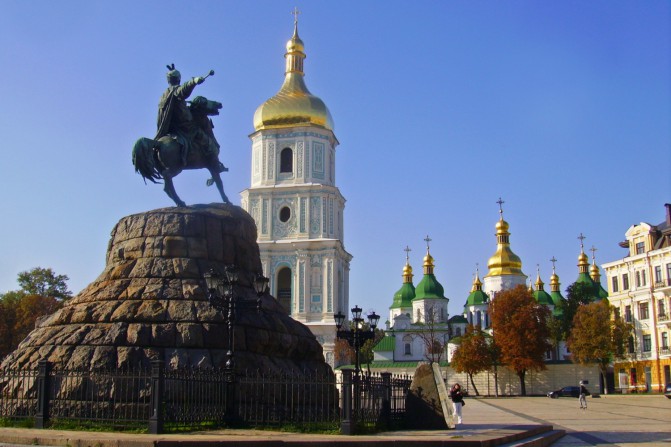
The historic hoax that cemented the USSR
The absence of the original text of the Pereiaslav Agreement gave the Kremlin free rein to interpret it to its advantage, turning it into a cornerstone of Russian colonial ideology.
The myth of the Pereiaslav Council surged during the Soviet era, though its interpretation fluctuated. In the 1920s, Soviet ideologues condemned it as a symbol of Russian colonialism, with Ukraine falling under the Muscovite monarchy. This view aligned with Marxist critiques of feudalism, which they saw as a backward system that paved the way for capitalism — the very system they sought to overthrow.
By the 1930s, however, the Kremlin began to shift its stance. Under Stalin’s push to create a “single Soviet nation,” which effectively merged subjugated peoples into a Russian-dominated identity, the Pereiaslav Agreement was reinterpreted as a “lesser evil” compared to Ukraine’s potential alignment with Poland or the Ottoman Empire.
It was gradually portrayed as a vital step toward the shared history of Russians and Ukrainians, laying the foundation for the USSR’s formation and the unification of all Soviet peoples. Soon, the Pereiaslav Council was rebranded as the “reunification” of Ukraine and Russia — a euphemism for Russian colonial influence that stretched beyond the USSR.
This narrative first emerged in September 1939, when the USSR, leveraging a secret pact with Nazi Germany, invaded Nazi-occupied Poland under the pretext of protecting local Ukrainian and Belarusian populations. The move was presented as a “reunification” of Ukrainians within the USSR, drawing on the Pereiaslav Agreement as a convenient historical precedent.
After World War II, the narrative flourished further. With the USSR annexing territories from Poland, Romania, and Czechoslovakia in the post-war settlement, the reimagined Pereiaslav Agreement was weaponized as a justification for expansion. It framed these land grabs as acts of self-determination — echoing the supposed 17th-century plea by Ukrainians to come under the tsar’s rule.
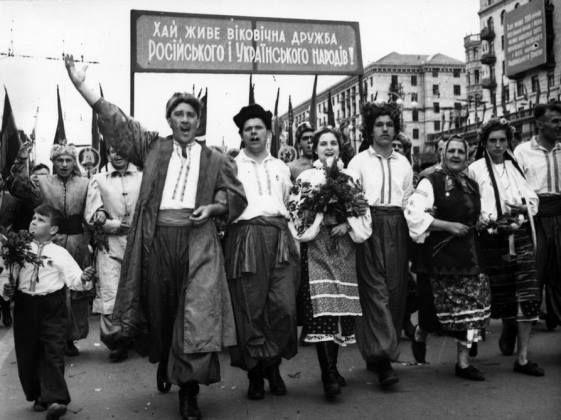
Inventing the “fraternal peoples”
The myth of the Pereiaslav accords reached its peak after Stalin’s death. In 1954, Nikita Khrushchev staged an elaborate celebration of the 300th anniversary, with grand festivities sweeping Moscow, Kyiv, and Lviv.
That same year, Soviet historians, under strict Communist Party orders, published the Theses on the 300th Anniversary of the Reunification of Ukraine and Russia (1654–1954), a blueprint for how the event was to be presented across all Soviet narratives.
From that moment on, Ukraine’s desperate military alliance in its fight for sovereignty was recast as part of a historically inevitable “friendship of the Russian and Ukrainian peoples.”
This interpretation became entrenched in Soviet political mythology, framing Ukraine’s further colonization as a deliberate, permanent surrender of its independence to Russia, corresponding to the “fundamental interests and aspirations of both nations.”
In this move, Soviet historiography completed the long ideological refinement of the narrative surrounding the treaty that supposedly marked the start of Russian-Ukrainian relations. In this version, one of Khmelnytskyi’s many temporary alliances — and the most desperate of them all — became reimagined as a historically predestined moment that united two “fraternal nations.”
The Pereiaslav council, which ended without any formal agreements, was interpreted as the moment when Ukraine supposedly surrendered its political sovereignty to Russia, choosing to tie its fate to that of the Russian nation.
Until the USSR’s collapse in 1991, related documents remained classified, and the true story of Khmelnytskyi’s rapprochement with Moscow, along with Russia’s manipulation of the Pereiaslav accords, was erased from history to fit the Soviet narrative.
In 1982, the myth took on a further symbolic dimension with the unveiling of the Arch of Friendship of the Peoples in the heart of Kyiv, marking the 60th anniversary of the USSR. One of its monuments, which stood until its removal in April 2024, featured a statue of Bohdan Khmelnytskyi alongside Tsarist envoy Vasily Buturlin, encapsulating the Soviet narrative of the “eternal friendship” between two “fraternal nations” for decades to come.
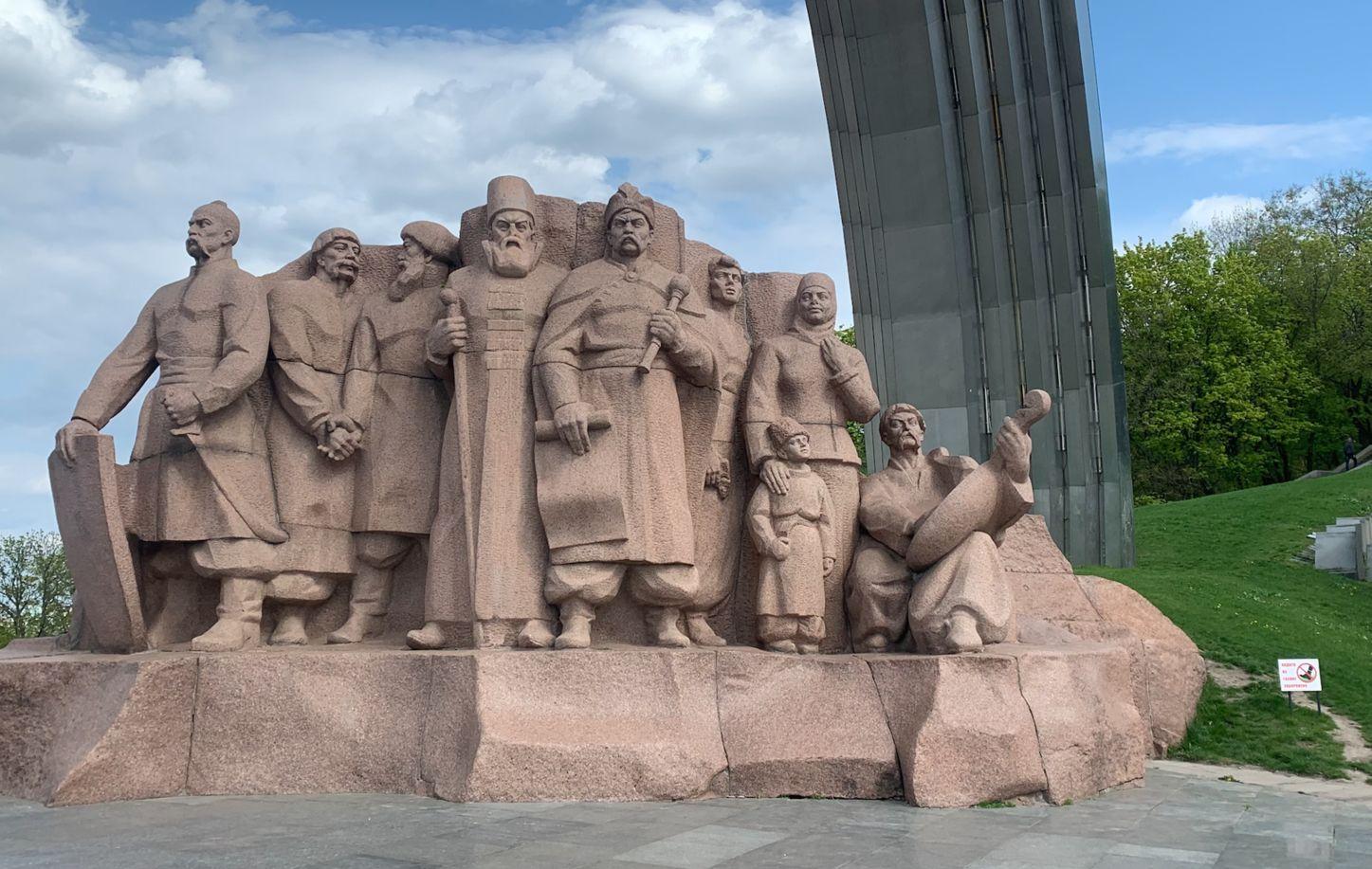
The real war resting on made-up history
The distorted Soviet myth of the Pereiaslav Agreements endured into modern times, becoming a cornerstone of Putin’s justification for claims on Ukrainian territories.
In July 2021, Putin published the article “On the Historical Unity of Russians and Ukrainians,” widely seen as a precursor to Russia’s full-scale invasion of Ukraine.
In this historically dubious piece, Putin echoes the Soviet narrative, asserting that “Russians, Ukrainians, and Belarusians are all descendants of Ancient Rus,” tragically divided by the decline of the medieval state — the Soviet-era rhetoric that laid the ideological groundwork for his expansionist agenda.
In Putin’s article, steeped in Soviet ideology, the Pereiaslav Agreement is cast as the pivotal chapter of Russian-Ukrainian history. He claims that “the ambassadors of Bohdan Khmelnytsky and Moscow visited dozens of cities, including Kyiv, where populations swore allegiance to the Russian tsar,” and that Khmelnytskyi supposedly thanked the tsar for bringing “the whole Russian Orthodox world under the strong and high hand of the Tsar.”
The Pereiaslav argument resurfaced once again in February 2024, during Putin’s interview with Tucker Carlson — his first with a Western journalist since the full-scale invasion. In the interview, Putin once again invoked the accords, claiming that Bohdan Khmelnytskyi “started writing letters to Moscow, asking to be taken under the strong hand of the Moscow Tsar.” Carlson.
Putin’s rhetoric on Pereiaslav accords erases Ukrainian agency, portraying Ukrainians as dependent on Russia for historical progress and using this narrative to justify his skepticism about Ukraine’s right to self-determination and sovereignty. This distortion of history serves as a tool to delegitimise Ukraine’s independence and perpetuate Russian imperial ambitions.
Putin’s interpretation took a new twist, serving his geopolitical ambitions. While the Soviet Pereiaslav myth framed the “reunification” as a way to escape Polish feudal exploitation, fitting the Marxist narrative of communism’s inevitable triumph, Putin’s version focuses heavily on the shared religious bond between the two nations.
He suggests this was the driving force behind Khmelnytskyi’s desperate push to bring Ukraine under eternal Russian control, portraying it as a shield against Polish Catholic oppression.
Putin’s religious spin on history is no accident. As a self-proclaimed leader of Orthodox Christianity — a mantle Moscow has held since the fall of Constantinople in the 15th century— the Kremlin’s rebranded its colonial ideology after 1991. Following the collapse of the USSR, which once justified expansionism through class struggle, Putin pivoted to a potent religious narrative.
During Putin’s, Orthodox Christianity has become central to the ideology of “the Russian world” — a region Russia sees as its rightful sphere of influence, defined by shared history, the spread of the Russian language, and the Orthodox faith.
Besides using this twisted interpretation of the Pereiaslav Council to delegitimize the Ukrainian statehood and justify its colonial claims on all the Ukrainian lands, the Kremlin actively enforces this myth by marking the days of the Pereiaslav Council across the occupied territories of Ukraine as as the “reunification of fraternal nations” it aims to complete by finalizing the conquest of Ukraine.
Read also:
• Inside Ukraine’s lost sovereignty battle that created world’s favorite Christmas song
• Russian web designer claims Ukrainian typography pioneer as “great Russian artist”
• The Soviets tried to steal Christmas. Ukrainians are taking it back
• Can Ukraine cancel Russia’s imperial history? Odesa debates decolonization

